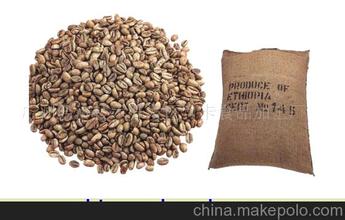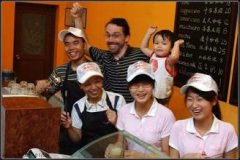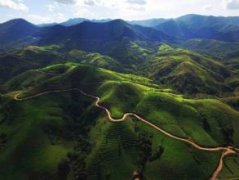A brief introduction to the Market Price of Vietnamese Fine Coffee Bean varieties

Coffee cultivation in Vietnam covers an area of about 500000 hectares, of which 10% are owned by state-owned enterprises and farms, and 85% by farmers and landowners. The scale of the manor is small, usually 2-5 hectares, and the large manor is about 30-50 hectares, but the number is small. Vietnamese coffee ranks second in all agricultural products exported from Vietnam, second only to rice. Every year, about 300000 farmers are engaged in coffee cultivation, with a labor force of 600000, and the labor force can reach 700000 to 800000 during the three-month harvest period. as a result, the coffee industry has absorbed 1.83% of the total labor force in Vietnam, and 2.93% of the total agricultural labor force. Vietnam's geographical location is very favorable for coffee cultivation. Southern Vietnam has a hot and humid tropical climate, suitable for growing ROBUSTA coffee, and the north is suitable for growing ARABICA coffee.
Coffee production in Vietnam has the following characteristics: (1) because there is no effective way to deal with fallen leaves, medium-grain coffee was selected as the main variety in the early 1980s. (2) based on the planting technology, the coffee planting method was determined, that is, under the hot and humid climate in southern Vietnam, high-density planting, massive irrigation, excessive fertilization and no shading trees were used to obtain the maximum yield, and give full play to the production capacity of medium-grain coffee. The per unit yield of many coffee plantations in Daklak, GiaLai, Kontum and DongNai areas of Vietnam reached 3mur4 tons per hectare. In some plantations, the yield per unit area is as high as 8 Muhami 9 tons per hectare. (3) processing technology: mainly making full use of the solar energy drying method of the dry season in the central plateau of Vietnam to process coffee to Vietnam, just as tea is important to the Chinese, it is a kind of penetration deep into the bone marrow. Almost all of the world's robusta coffee beans (Robustabean), which are often used to make instant coffee and high-end coffee blends, are exported from Vietnam. Vietnam is the world's second largest exporter of coffee, surpassing Colombia and second only to Brazil. Vietnam has a long history of coffee production, but the development and expansion of its production scale began in the last 20 years. After experiencing the crisis of ups and downs in the world coffee market from 2001 to 2005, Vietnam's coffee industry gained momentum. In 2005, it handed in a satisfactory answer for the world: Vietnam produced 810000 tons of coffee (13.5 million bags, 60 kg each) from 2001 to 2006. Exports reached 776 tons (12.9 million bags), and exports increased by 35%. Vietnamese coffee is produced in Vietnam, just as tea is important to the Chinese. It's a penetration deep into the bone marrow. Almost all of the world's robusta coffee beans (Robustabean), which are often used to make instant coffee and high-end coffee blends, are exported from Vietnam. Vietnam is the world's second largest exporter of coffee, surpassing Colombia and second only to Brazil
G7 coffee is one of the most famous coffee in Vietnam. Each coffee bean is selected from the best coffee area in the Vietnamese plateau and baked with special cream. The creamy, mellow Wiener three-in-one instant coffee is produced and exported by Vietnam Bian Heweina Co., Ltd., the market share of Vina coffee in Vietnam has been maintained at more than 45%, in the leading position. At present, Wiener has participated in the China-ASEAN Expo for many years in a row, and some influential exhibitions in the mainland often see the geographical location of Wiener Coffee in Vietnam is very favorable for coffee cultivation. Southern Vietnam has a hot and humid tropical climate, which is suitable for growing ROBUSTA coffee, while the north is suitable for growing ARABICA coffee. Each coffee bean currently produced in Saigon Coffee is selected from the best coffee area in the Vietnamese plateau and is made with special cream, with outstanding milky aroma, mellow coffee aroma, prominent coffee aroma and unique flavor of Saigon coffee. Vietnam's coffee yield is as high as 950 kilograms per hectare and many newly planted coffee trees are invested by the Japanese.
Two years ago, I read a survey report that Vietnam has overtaken Colombia in coffee bean production, ranking second in the world after Brazil. But it is planted with Robusta trees, and there is still a big gap in the quality of coffee beans compared with countries such as Colombia and Brazil. Vietnam's coffee production is growing. Among Vietnam's new export products, tea ranks first and coffee ranks second. The main varieties produced are Robbite coffee beans, which exported 66000 bags in 1980 and soared to more than 200,000 tons in 1994. 96% of Robert's coffee comes from small farms, but some state-owned farms also grow coffee trees, perhaps under the influence of French colonial rule, and coffee grown in Vietnam has a French flavor. Arabica coffee was first brought to Vietnam by French missionaries. From 1865 to 1876, more than 400,000 coffee trees were introduced to Vietnam and planted near Tonkin Bay, mostly Java or bourbon varieties.
Vietnam's geographical location is very favorable for coffee cultivation. Southern Vietnam has a hot and humid tropical climate, which is suitable for growing ROBUSTA coffee, while the north is suitable for growing ARABICA coffee. Coffee production in Vietnam has the following characteristics: (1) because there is no effective way to deal with fallen leaves, medium-grain coffee was selected as the main variety in the early 1980s. (2) based on the planting technology, the coffee planting method was determined, that is, under the hot and humid climate in southern Vietnam, high-density planting, massive irrigation, excessive fertilization and no shading trees were used to obtain the maximum yield, and give full play to the production capacity of medium-grain coffee. The per unit yield of many coffee plantations in Daklak, Gia Lai, Kontum and Dong Nai areas of Vietnam reached 3mur4 tons per hectare. In some plantations, the yield per unit area is as high as 8 Muhami 9 tons per hectare. (3) processing technology: mainly making full use of the solar energy drying method in the dry season in the plateau of central Vietnam to process coffee.
Coffee cultivation in Vietnam covers an area of about 500000 hectares, of which 10% are owned by state-owned enterprises and farms, and 85% by farmers and landowners. The scale of the manor is small, usually 2-5 hectares, and the large manor is about 30-50 hectares, but the number is small. Vietnamese coffee ranks second in all agricultural products exported from Vietnam, second only to rice. Every year, about 300000 farmers are engaged in coffee cultivation, with a labor force of 600000, and the labor force can reach 700000 to 800000 in the three-month harvest period. as a result, the coffee industry has absorbed 1.83% of the country's total labor force and 2.93% of the total agricultural labor force.
Vietnam Coffee Corporation (VINACAFE) is a 100% state-owned enterprise with 73 companies and farms under its jurisdiction. VINACAFE exports 20-25% of Vietnam's coffee production each year.
According to the business statistics of Vietnam Coffee Association, in 2000-2001 (from October 2000 to September 2001), a total of 874676 tons of coffee were exported from 149 units in Vietnam, of which the three largest export companies were OLAM (wholly foreign-owned enterprise, 21326 tons), DAKMAN (joint venture, 18076 tons) and VINAFIMEX (local enterprises, 13719 tons).
The Vietnam Coffee quality Standards Committee was led by the Vietnam Coffee Association to draft the Vietnam National Coffee Standard, which was reported to the Ministry of Science, Technology and Environment (now the Ministry of Science and Technology) for examination and approval. [3]
In the field of coffee processing, there have been some dilapidated processing plants since 1975, and there are several processing plants in northern Tongjiao, Fukui and other places, whose equipment was made in East Germany from 1960 to 1962. In the south, the old factories left by former landowners such as ROSSI,DELPHANTE are also small. While expanding the coffee planting area, Yue also began to build new coffee processing plants, first producing some stand-alone equipment, and later imitating the production line according to the HANGXA style, the main manufacturers are the Haiphong May 1 Machinery Factory, the Ministry of Industry A74 Plant in Shoude, Ho Chi Minh City, and so on. In recent years, many companies and farms in Vietnam have imported new processing plants with relatively complete equipment from Germany and Brazil, and imported more than a dozen sets of coffee processing production lines from PINHALENSE of Brazil. Since then, more and more factories began to imitate and improve their own production of Brazilian equipment. In recent years, the processing capacity of Vietnamese coffee has been greatly improved, which can guarantee the export of 150000 to 200000 tons of coffee kernels per year. In addition, there are many enterprises with inadequate equipment, which only rely on a few stand-alone machines for processing, and purchase newly processed coffee from farmers to ensure export standards. The coffee purchased from the private sector is mainly handled by each farmer through the cement yard or soil yard. Farmers in many places use small grinders to grind dried coffee fruits into coffee kernels and sell them to coffee buyers. This kind of processing leads to the instability of product quality. Coffee produced by companies and farms is usually of good quality and beautiful appearance, such as thang loi, phuoc an, viet duc, buon ho, Deloitte, etc., which are recognized by customers. Generally speaking, the sale of coffee has not been carried out in accordance with national standards for a long time, and the quality provisions in the sale and purchase contract are very simple, which are only determined through consultation between the buyer and the seller, which can not effectively promote the improvement of coffee quality and the level of the processing industry.
Important Notice :
前街咖啡 FrontStreet Coffee has moved to new addredd:
FrontStreet Coffee Address: 315,Donghua East Road,GuangZhou
Tel:020 38364473
- Prev

A brief introduction to the history and culture of the origin and development of Vietnamese boutique coffee beans with light sour taste
Coffee production in Vietnam has the following characteristics: (1) because there is no effective way to deal with fallen leaves, medium-grain coffee was selected as the main variety in the early 1980s. (2) based on the planting technology, the planting method of coffee was determined, that is, under the hot and humid climate in southern Vietnam, high density planting, large amount of irrigation, excessive fertilization and no shading trees were obtained.
- Next

A brief introduction to the cultivation of medium-grained Vietnamese boutique coffee beans, geographical location, climate and altitude
In the field of coffee processing, there have been some dilapidated processing plants since 1975, and there are several processing plants in northern Tongjiao, Fukui and other places, whose equipment was made in East Germany from 1960 to 1962. In the south, the old factories left by former landowners such as ROSSI,DELPHANTE are also small. While expanding the planting area of coffee, it also began to build new coffee processing plants, initially producing some
Related
- Detailed explanation of Jadeite planting Land in Panamanian Jadeite Manor introduction to the grading system of Jadeite competitive bidding, Red bid, Green bid and Rose Summer
- Story of Coffee planting in Brenka region of Costa Rica Stonehenge Manor anaerobic heavy honey treatment of flavor mouth
- What's on the barrel of Blue Mountain Coffee beans?
- Can American coffee also pull flowers? How to use hot American style to pull out a good-looking pattern?
- Can you make a cold extract with coffee beans? What is the right proportion for cold-extracted coffee formula?
- Indonesian PWN Gold Mandrine Coffee Origin Features Flavor How to Chong? Mandolin coffee is American.
- A brief introduction to the flavor characteristics of Brazilian yellow bourbon coffee beans
- What is the effect of different water quality on the flavor of cold-extracted coffee? What kind of water is best for brewing coffee?
- Why do you think of Rose Summer whenever you mention Panamanian coffee?
- Introduction to the characteristics of authentic blue mountain coffee bean producing areas? What is the CIB Coffee Authority in Jamaica?

